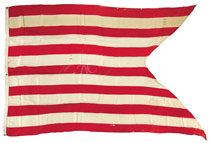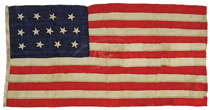The Zaricor Flag collection: Two Centuries of Concord & Conflict
The Zaricor Flag Collection (ZFC), as the noted flag historian, the late Howard Madaus stated, Is the largest most important representation of U.S. and American flags in the world. Containing many important foreign flags, the ZFC is more than a large accumulation; rather it is a dynamic working collection, used for research, exhibition and educational purposes. Read more >>
INTRODUCTION
13 Star Flags & the 150th Anniversary of the American Civil War
by the Collector
The Zaricor Flag Collection is unique for the large number of original 13 star flags in the collection and more as it contains six different patterns in one collection of eight. This representation gives us an idea of what was in the public's mind when the country declared it's democratic principals being the first secular nation state not based on religion or a monarchy. These diverse patterns of eight suggest that likely many more star patterns existed, which we see, in later star counts. It was the norm not the exception that it reflected a country again of diverse ideas that drove us toward a republic where the individual was paramount and those principals reflected in the Constitution were not only to be protected and preserved but to be the driving force of a dynamic evolving country, where the vastness of the continent before that early generation of revolutionary Americans ensured that there was ample opportunity for all.
This particular expression reflected through different star patterns in the national flag and continued for the next 140 years until the federal government standardized the star patterns of the national flag for the official business of the country but the individual’s Right of Expression continued to be paramount. We are able to design our flag as we each wish as long as it meets the criteria of the First Flag Act of 1777. It must have stripes and stars and contain red, white and blue in no particular order. The flag still speaks to us today that we are a nation of individuals where our expression as individuals is protected from the tyranny of the majority.
One other notable aspect about the ZFC containing the largest selection of original thirteen star flags is how they became part of this collection. I call it fortuitous but logical and probably never to happen again. First the number of early American National flags is rare and infrequent to discover because there were so few made due to the lack of demand and that the size of government was extremely small until the American Civil War. Second, the period of the early flags with star counts of 13 to 29 (1777 - 1847) was for the most part prior to the US Industrial Revolution (1830's to WWII) which did not get into high gear until the 1840's; the cotton gin was perfected in the 1830's before it was widespread; the sewing machine was introduced in 1849; and block printing in the 1840's, all of these directly affected flag making. Prior and still past this period flag making was and remained a cottage industry with minimal industrial organization. True the UK and much of Europe experienced it mush sooner but the affect on America was interrupted with revolution both here and there. The Napoleonic War, the War of 1812 and our export development took time to accumulate and attract enough capital to role out the industrial revolution, which had it's first national effect with the development of the Erie Canal and railroads, which to a limited extent they were still in their infancy until 1840's.
Given the fact that flag demand was low, the early flags that did survive are few in number. Identification has been difficult because of a misunderstanding within the conservation trade that cotton was not available in flag making until 1800. The belief was that cotton was not available in the form of thread and cotton sheeting, this has been proven incorrect with the discovery of several factories that were producing cotton goods that were not well known within the conservation trade. In addition, this realization, the low demand and other fabric alternatives such as silk and linen contributed to the low demand for cotton in flag making. Some conservationist even believed cotton itself was not available until 1800, all one has to do is look for it as it was used from slave clothing to fine dresses, coverlets, and other household goods. It is just that cotton demand for flag making started slow and first documented use was early as the mid to late revolution period. Cotton is more durable than most fabrics of the period increasing it's chance to survive. It was rare to find an all cotton flag in the early period due to the characteristics for flag usage is not preferred, it's weight and ability to hold water making it undesirable for outdoor use. Furthermore, in the early period cotton was considered expensive, as the cotton gin was still some time away. For thread, stars and hoist it was desirable and readily available domestically or imported and if embargo then by black-market could fulfill demand.
The ZFC is not one collection, it is made up of many different collections and the 13s are just one example of 40 years of collecting. The eight original 13 star flags in the ZFC were acquired from five museums, historical societies, and prominent collectors/dealers of early American relics. These five contacts together span a total of 465 years of collecting. The 13 star flags were collected or acquired early in their repository before collecting flags grew in popularity in 2001. It is believed by several experts that most if not all the major undiscovered collections have been culled through. I do not share that view it is one I believe has a point and it is only in my generation that it has been possible to travel all the US and overseas by jet, and have the ability to make a call, send a fax and now personal computers and e mails, place bids at auctions in seconds while one is doing something else completely different at the same time. most importantly, immediate and convenient access to a full library of knowledge almost instantly allow collections such as this to be created. It is the knowledge that is now available that was not in the past that made it possible to rediscover lost flags such as these thirteens.
Iconic Early American & British Flags, 1805 - 1865
U.K Jack - HMS Spartiate, Battle of Trafalgar, 1805
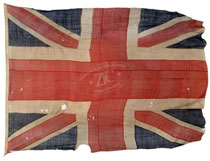
ZFC3400. Exceptionally rare Union Jack flown on HMS Spartiate at the Battle of Trafalgar. A rare and finely preserved Union Jack flag which was flown from the jackstaff of HMS Spartiate at the battle of Trafalgar on the 21st October, 1805. It is the last documented flag to survive from that iconic battle.
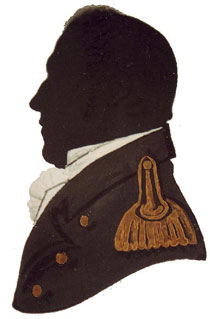
The flag was originally in the possession of Capt. James Clephan R.N. (1768-1851) who subsequently passed it down to his descendants whence it came into possession of the Zaricor Flag Collection in 2009. See ZFC2575 for companion piece captured in War of 1812. Read More
U.S. 17 Star, 17 Stripe Privateer Ensign 1812
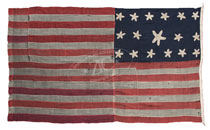
ZFC2575. 17 Star, 17 Stripe U.S. Ensign, Privateer Blockade, War of 1812 captured by Captain James Clephan, HMS Charybdis. This flag is significant for its rarity and symbolic importance. There are no other 17-stars with 17-stripes known U.S. flags to survive. Read More
U.S. Early Militia Regimental Color 1812 - 1829
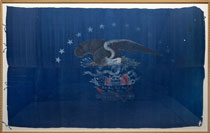
ZFC3754. This hand-painted, blue silk color is under review and its history is currently being researched. It was identified at auction as an 1830s New York State Militia (NYSM) flag; however it bears none of the traditional attributes of existing NYSM flags, bringing that credit into doubt. Instead it is thought to be an early militia regimental color created for an unidentified unit sometime during the 1812 to 1830s period. Read More
The Decaturs - America's Iconic Military & Naval Family Collection for over 100 years
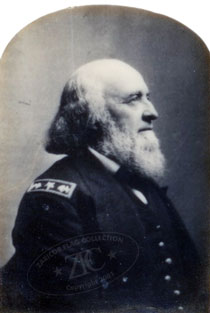
ZFC3536/ZFC3543/ZFC3535. The name Decatur is one of the most revered names in American naval history. Commodore Stephen Decatur (1814-1876) was a 19th century American naval officer whose career spanned the years 1829 to 1876. Decatur was born in 1814 in Newark, New Jersey. He was appointed a midshipman in 1829. Prior to 1845, the establishment of the U.S. Naval Academy midshipman in the U.S. Navy was dependant on the officers of the ships or shore establishments to which they were assigned for instruction in the naval sciences. Read More
30 Star No. 1 Ensign USS Constitution 1845 - 1850
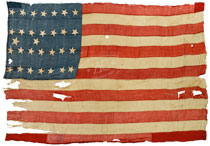
ZFC2588. This 28-star ensign, made to commemorate the admission of Texas is from the most famous ship in the United States Navy, the USS Constitution. These U.S. ensigns with these particular star counts were official between 1846 and 1851. Read More
Rendering of the first visit of the Pope on US Sovereign Territory on the USS Constitution, Mediterranean, 1849
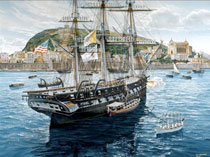
30 Star No.1 Ensign (ZFC2588) flying on the stern.
ZFC3763. In the history of the United States Navy, no ship has as much tradition, lore and heritage as the USS Constitution. She was commissioned on 21 October 1797 and
is often referred to by her nickname "Old Ironsides". Virgin American Oak was used in her construction and to strengthen the keel, additional "ribs" were spaced closer together which resulted in enemy cannon balls bouncing off the sides, hence the nickname: "Old Ironsides." Read More
150th Anniversary of the American Civil War
Iconic Military & Naval Flags
Jack of the CSS Patrick Henry - Captain Parker 1863 - 1865
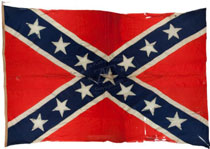
ZFC2591. This large wool flag is the 1863 - 1865 jack of the Confederate States Navy (C.S.N.). According to the Table of Allowances for C.S.N. a jack with a hoist of 8" would have been styled as a No. 3 Jack, the third largest of the eight jacks specified for the C.S.N.
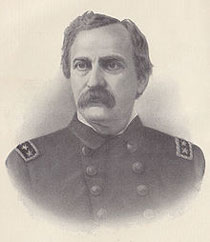
This jack is inscribed "Capt. Parker". A review of the roll of the commissioned officers of the C.S.N. reveals only three officers with the surname Parker. One, J.H. Parker was a 2nd Assistant Engineer, ranking equivalent to a master (on modern terms an ensign, the lowest grade of commissioned officer); another C.M. Parker was a Passed Assistant Surgeon, ranking equivalent to a lieutenant, leaving only First Lieutenant W.H. Parker as a serving as a line officer. Read More
Second National Ensign of the CSS Alabama, 1864

ZFC2590. This flag is the second and final ensign from the CSS Alabama's last battle, hoisted after the spinnaker gaff on which she wore her ensign was shot away. This smaller ensign, likely a boat flag, was eventually struck in a battle against the USS Kearsarge off the coast of France in 1864.The CSS Alabama was one of the most famous ships of the Confederate Navy. Perhaps second only to the battle between the USS Monitor and the CSS Virginia, the epic 19 June 1864 battle fought between the USS Kearsarge and the CSS Alabama off of Cherbourg, France is certainly the most romanticized. Read More
THE ORIGINAL 13 STAR U.S. FLAGS
13 Star United States Flag - Great Star in Glory, 1783 - 1790

ZFC0604. This 13 star Great Star flag is made of wool bunting with six-point, linen stars gracing the canton. These features point to early federal period origins, especially the six-pointed stars, which are a common feature of 18th century flags. Read More
13 Star United States Flag - Revolution & Federal Periods, 1784 - 1791
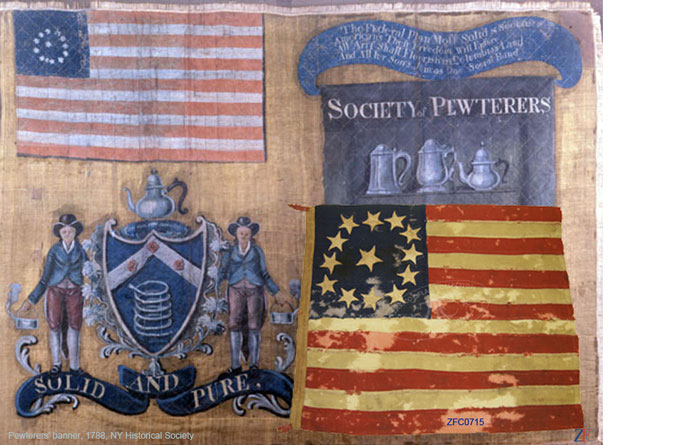
ZFC0715. The majority of Americans are familiar with the term "the Betsy Ross flag" - a U.S. flag that was believed to feature 13 stars arranged in a circle with no stars in the circle. The Betsy Ross flag is also known for being the first ever United States flag with origins that back to 1777, it is a story or belief that has never been documented. It was only in the 1870s that the family of Betsy Ross began to promote the Betsy Ross story. Read More
U.S. 13 Star Flag - Hancock & English.

ZFC0624. Believed to be one of the oldest surviving 13-star flags from the early period of American history, this flag, from Salem, MA, bears blue stars on-white, and reverses the traditional motifs. The placement of blue stars on a white canton is extremely rare. Read More
13 Star Flag Salem, Massachusetts, 1777 - 1785
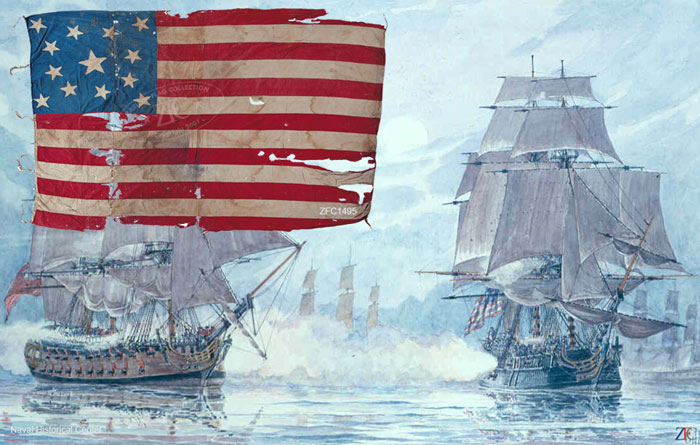
ZFC1495. When first sold at an auction as a 13-star Revolution period ship's flag. ZFC concluded this flag was most unusual due to the use of all cotton materials in it's construction. In the very early period in the colonies/states the use of cotton for flag making was generally limited to specific areas of the flag such as the stars, thread and hoist due to it generally being expensive and especially not well suited for maritine use due to it's tendency to act as a sponge when it came in contact with water. Therefore, ZFC suspected the claim for this flag was probably exagerated and we expected it could not pass the textile test. However, in fact, upon examination by a foremost textile expert (see report) it was concluded indeed the materials and construction details were and used in the 18th century. The construction techniques used and dated to the 18th century. Read More
13 Star United States Custom House & Revenue Ensign, 1790s
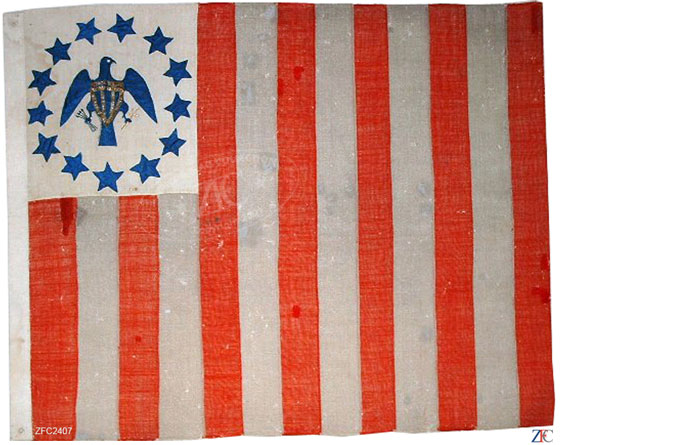
ZFC2407. This flag is believed by ZFC to be the oldest surviving U.S. Revenue Marine Ensign and Custom House flag since their authority were confirmed by Congress in 1791. It is hand-sewn with an open weave wool bunting for the stripes over a silk canton. In fact this flag is either a variant of the 1799 regulations of which only a letter still exist, as the original regulations were destroyed when the British burned Washington DC in 1814. Read More
13 Star Flag - Privateer Minerva, 1783 - 1785
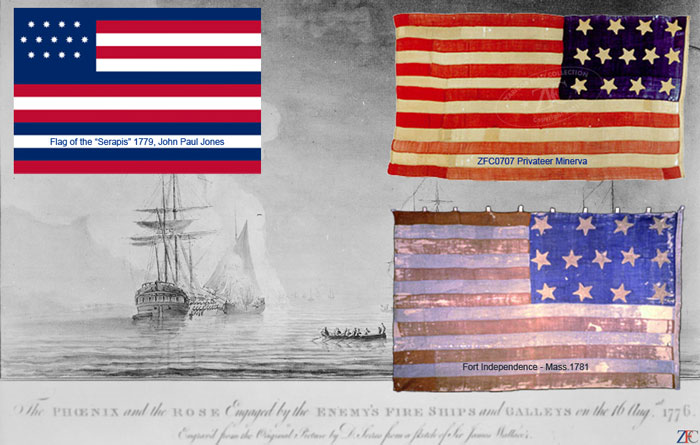
ZFC0707. Our research indicates this flag is the hand-sewn ensign from the Revolutionary Privateer Minerva and may be the only named ensign to have survived from the American Revolution. It was formerly part of the acclaimed collection of noted antique dealer Mr. Boleslaw Mastai and his wife Marie-Louise D'Otrange Mastai. Read More
13 Star United States Flag - Sandy Hook Lighthouse, 1783 - 1791
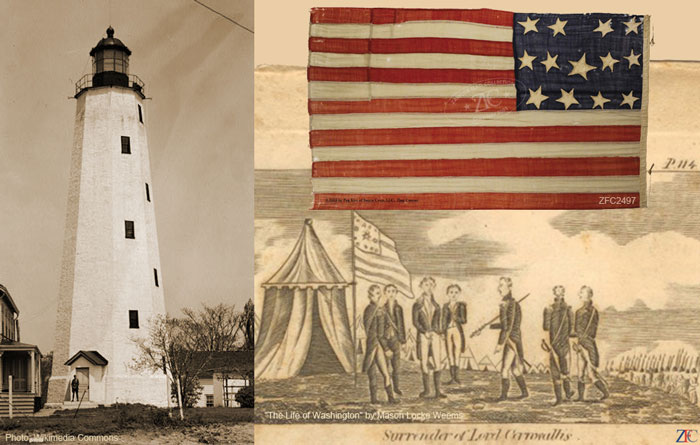
ZFC2497. This wool, 4-5-4 star pattern, 13 Star United States flag, is one of the earliest documented American flags in existence. From the Old Sandy Point Light House, New York in 1790, it was made shortly after the government was formed and flown under the authority of the Department of Treasury's Lighthouse Establishment, one of the federal government's first bureaucracies. Read More
13 Star United States Merchant Ensign, 4-5-4 Star Design, Early Federal Period, 1783 - 1791

ZFC0419. The early history of this flag is unknown, but it originates from the personal collection of noted collector William H. Guthman, founder of Guthman Americana in Westport, Connecticut where he was a respected dealer, scholar and author, and was considered a preeminent authority on Colonial and Federal period militaria. Read More
150TH ANNIVERSARY OF THE AMERICAN CIVIL WAR
The Flag at War with Itself, 1851 - 1861
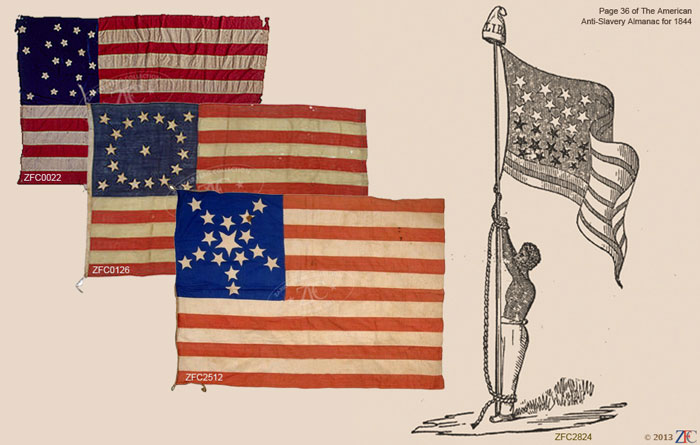
ZFC0022/ZFC0126/ZFC2512. The American Civil War was fought between the Northern and Southern States. Nullification, States rights, Slavery and Abolition were all causes of internal discord. Preceding the outbreak of armed hostilities there was a period of simmering tensions wherein the United States was tearing itself apart. This division began to be represented on flags. In 1844 William Lloyd Garrison's Anti-Slavery Almanac displayed on the verso cover an image of a stylized 26 star U.S. flag with 12 white stars and 14 black stars. Read More: ZFC0022 and ZFC0126 and ZFC2512
The Capture of the First American Flag, January 1861

ZFC2510. When the American Civil War began there were 33 stars on the United States Flag, a star-field count that saw the nation tearing itself apart. This Zaricor Flag Collection Grouping contains three remarkable 33 star flags: the first United States flag captured in January 1861, some four month prior to the firing on Ft, Sumter; the earliest known California militia national color used in the 9 April 1861 "Settlers War", some three days before Confederate guns fired on Ft. Sumter; and, an exquisite 33 star Grand Luminary camp flag from Pennsylvania. There are two flags associated with the 19 April 1861 "Pratt Street Riots", generally regarded by historians as the first bloodshed of the American Civil War. Read More
General Philip Sheridan & U.S. Mounted Troops, 1864-1865

ZFC2576. It was Sheridan"s leadership and performance that changed the United States Mounted Troops forever, who now for the first time were organized and utilized as a separate combat arm. In 1885 he restored the red over white guidons used by the U.S. Cavalry that are still used in the present day. Read More
General George Armstrong Custer 3rd Personal Guidon, 1864-1865

ZFC0489/ZFC0490. Presented here are two of Custers guidons; the Army of the Potomacs third Division Headquarters and personal guidons used by George A. Custer during the famous and brilliant Shenandoah Valley Campaign. It was used again later during the American Civil War. These two guidons, separated upon Custer's death in 1876 into different family branches of the Custer descendants, were reunited by the Zaricor Flag Collection in 1995. Read More: ZFC0489 and ZFC0490
U.S. Army Bgd HQ Flag, Gen. James Wilson, 1864
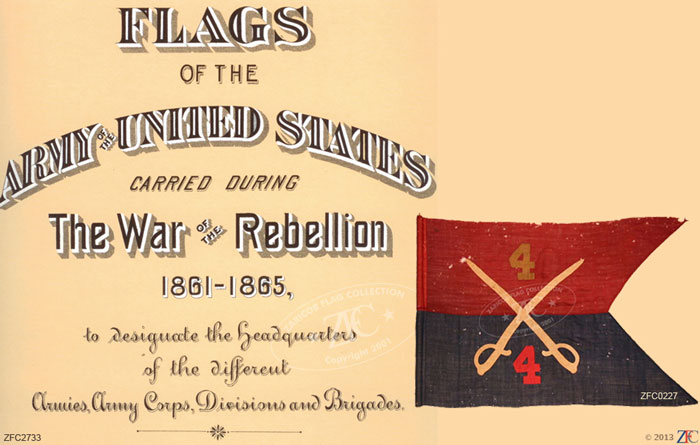
ZFC0227. During the nearly six months that Brigadier-General James Wilson held the command of the 3rd Cavalry Division of the Army of the Potomac, he had frequent contact with his successor; Brigadier-General George A. Custer and he undoubtedly saw Custer's personal flag on several occasions. It is not totally surprising; therefore, that when Wilson sought designs to distinguish the brigade headquarters of the cavalry corps he was sent west to command in September of 1864, that he ended up choosing designs with which he was familiar. Read More
35 Star U.S. Flag - Major General George Thomas
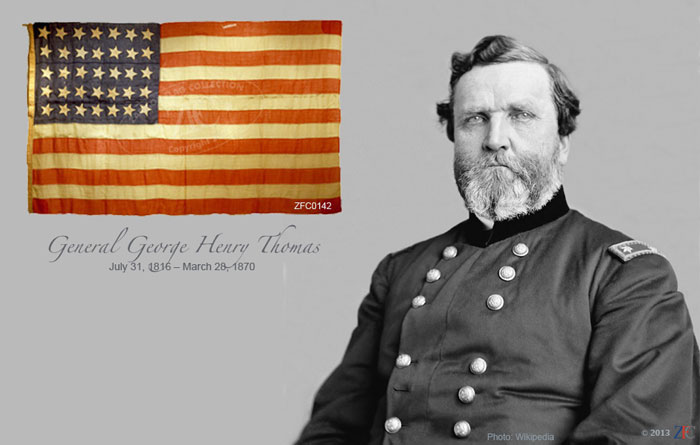
ZFC0142. This period example flag was made to mark the admission of West Virginia as the 35th state on June 20, 1863; and would remain accurate until the admission of Nevada on October 31st 1864, a period of 1 year, 4 months, 11 days, and would remain official until July 4th 1865. Read More



































